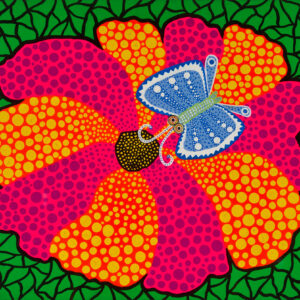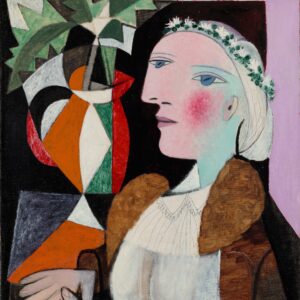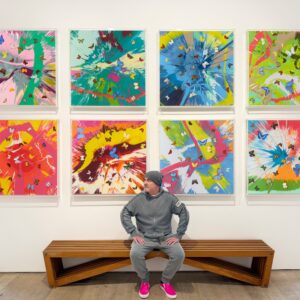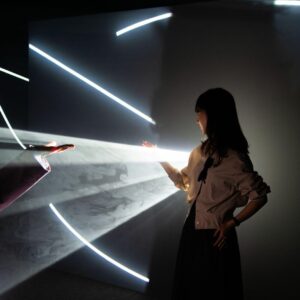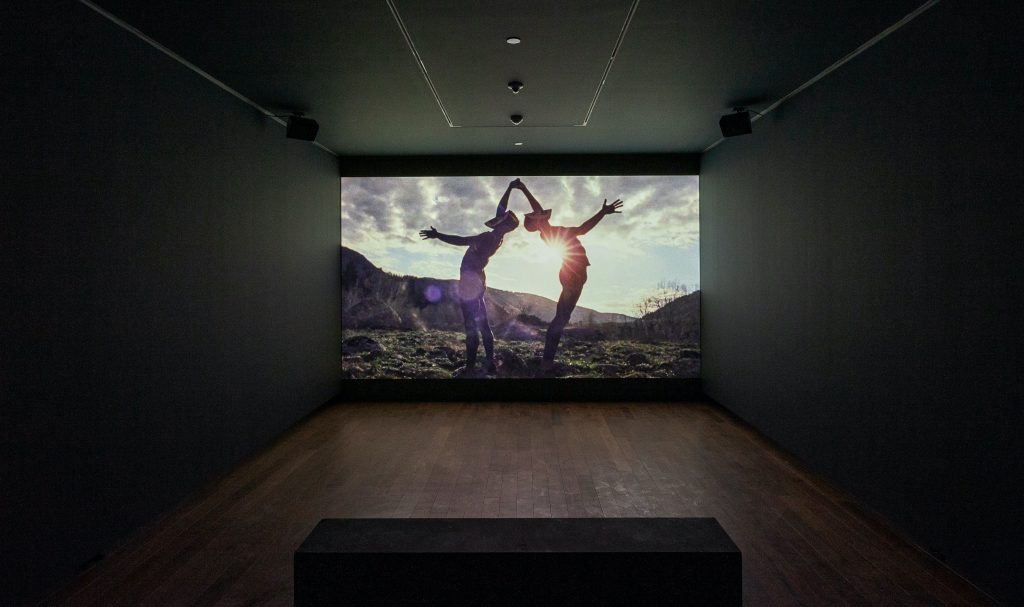
Rashid Johnson, The Hikers, 2019. Courtesy the artist and Hauser & Wirth. Photograph: David Levene.
As this year’s Istanbul Biennial comes into its final weeks, we visited the city to experience the 16th iteration of the renowned fair.
Similarly to previous years, the latest Istanbul Biennial is spread out across the Turkish capital, occupying gallery spaces, pre-existing museums, parks and on this occasion an entire island. The Biennial boasts the work of 56 international artists, with 37 entirely new pieces, including a collection of diverse site-specific sculptures. The range of locations, artists and mediums creates a wholly unique experience, not only in contrast to comparable cultural initiatives, but in every area and space of the Biennial itself.
Curated by Nicolas Bourriaud, the Biennial’s title, The Seventh Continent, refers to its main concern; how human activity has and is shaping our world. The title directly addresses one of the most potentially damaging consequences of human impact imaginable; the creation of a gigantic area of plastic waste, the size of a continent, in the middle of the Pacific Ocean. This is something Bourriaud describes as showing that: ‘humans are now fully part of the world’s evolution… and sees the traditional Western separation between nature and culture fading away’.
In this instance, artists were invited to propose works that reflect on this concept and to investigate the role of contemporary art under the climate crisis. In order to do so many artists sought to create their own worlds, alternative universes and entirely new civilisations, some mirroring our experiences in years to come, while others are almost paralleling society now, with only slight divergences, but changes that once spotted open up a stream of questions.
It is at the Pera Museum that we encounter a number of these imagined worlds and civilisations. The exhibition begins with a presentation of works by Norman Daly, showcasing the artist’s imagined ancient society of ‘Llhuros’. Daly’s creation of objects, mixed with poetry and references to music, bring to life a world relatable to our real histories, but also one that also allows us to openly view questionable choices made, and how these decisions ultimately result in the collapse of civilisations. Which, as Bourriaud explains ‘corresponds exactly to the confused era in which we live: today, the past is just as falsifiable as the present or future’.
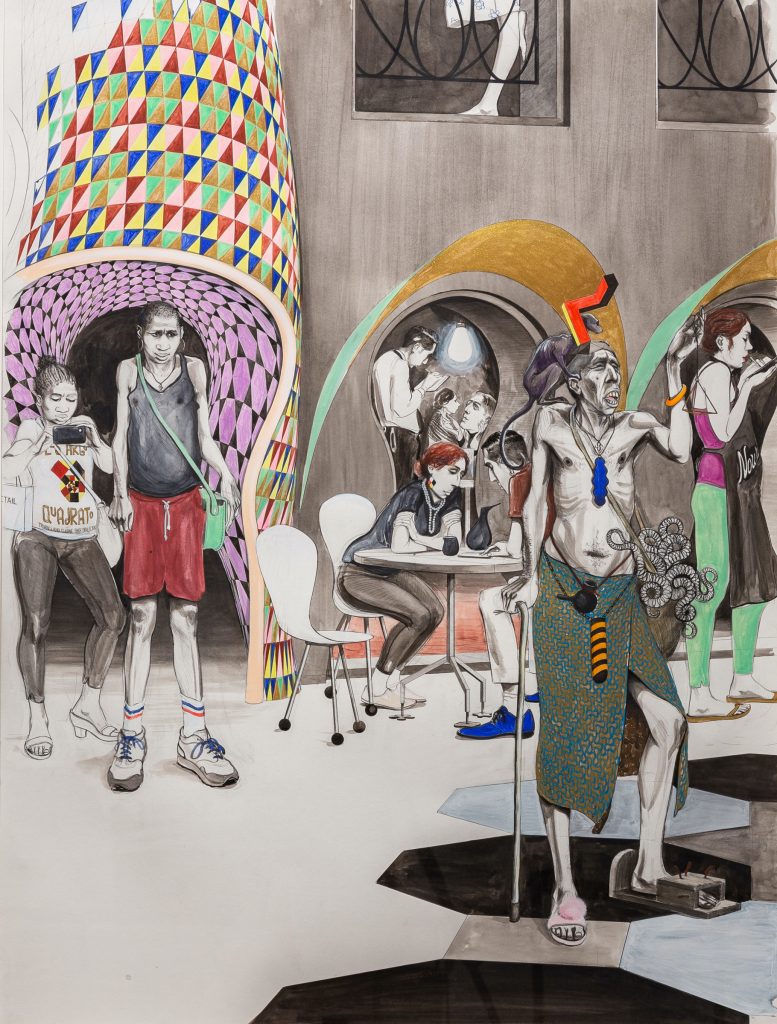
Charles Avery, Untitled (Shaman Outside Noumenology, Onomatopoeia. Courtesy the artist, GRIMM Amsterdam | New York and Ingleby Gallery, Edinburgh. Photograph: David Levene.
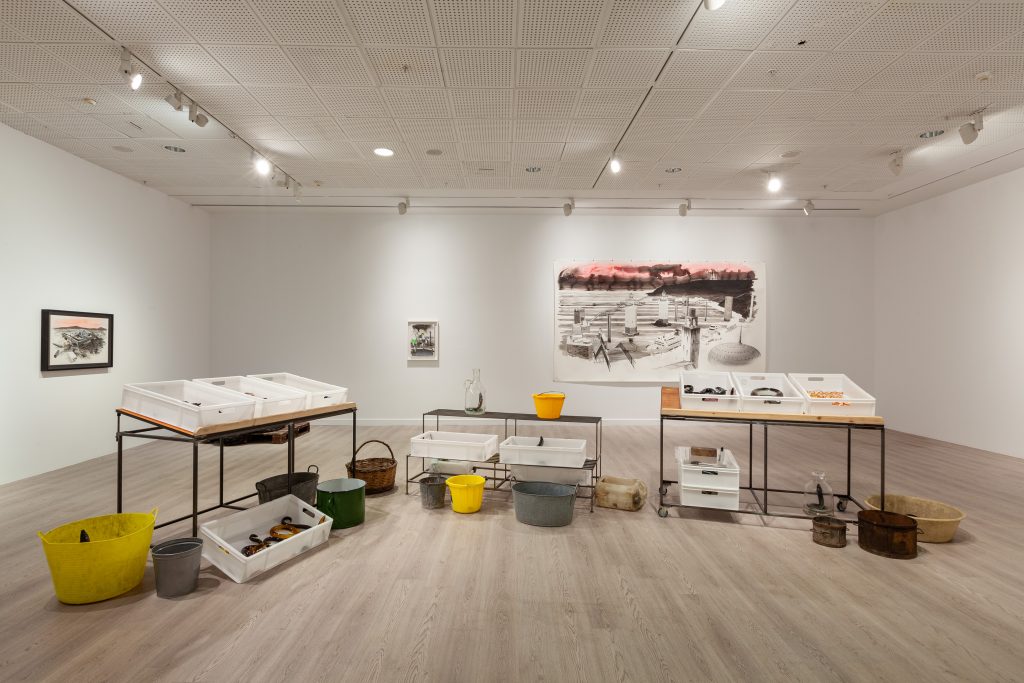
Charles Avery, Istanbul Biennial Installation. Courtesy the artist. Photograph: David Levene.
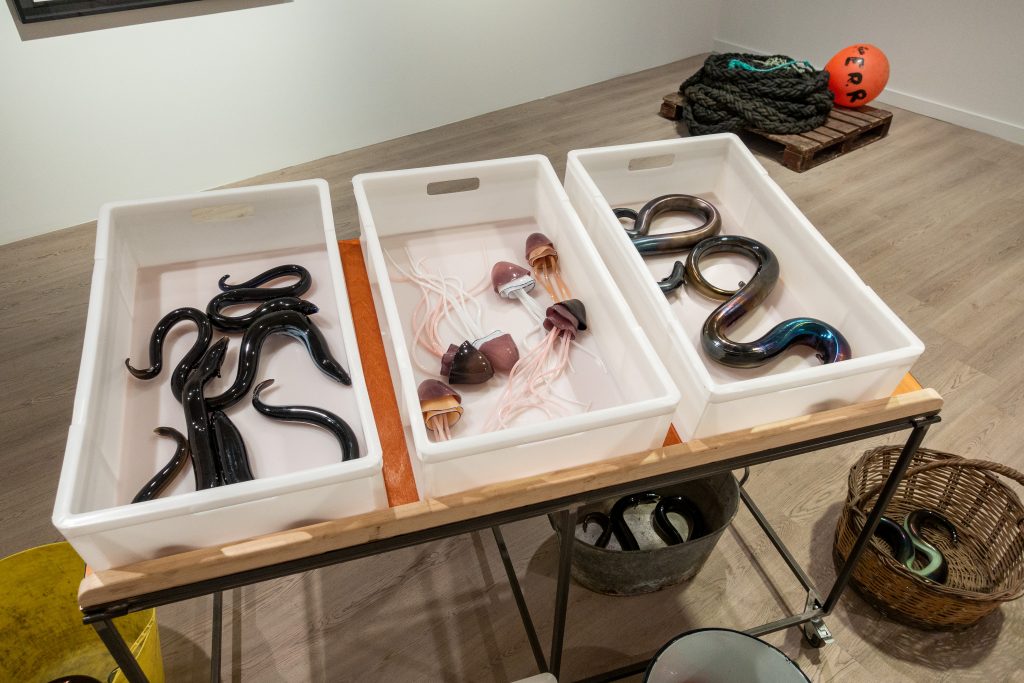
Charles Avery, Untitled (Ninth Stand no 1+1). Courtesy the artist and Ekard Collection. Photograph: David Levene.
Following on from Daly’s works, visitors discover a room dedicated to British artist, Charles Avery. Avery’s striking installation incorporates drawing, painting and sculpture to evoke the artist’s fictional Island and it’s main town of Onomatopoeia. Centred around a constructed fish market, but with the animals replaced by intricate hand-blown glass creatures, including seaurchins, eels and squid, the outer drawings of detailed architectural structures and eccentric characters bring to life a world not so far from our own, but also one that when examined closely fosters haunting undertones of tension and obscenity. The people, troubled and disfigured, occupy areas of extreme pollution and toxic waste, urging visitors to consider their own impact on the world.
While the works at the Pera provide a picture of the recognisable other, it is on the island of Büyükada, the largest of Turkey’s Princes’ Islands, that visitors discover site-specific works of a different kind, pieces that dramatically change the landscape and surroundings they are situated in.
Accessed from the mainland by a two-hour boat journey and with no cars allowed on the Island, the only means of transport being by bike or horse drawn carriage, Büyükada holds a certain mystery and allure the moment one walks down its pier. Located on the Island are the works of six artists, which inhabit waterfront promenades, decaying mansions and hilltop gardens.
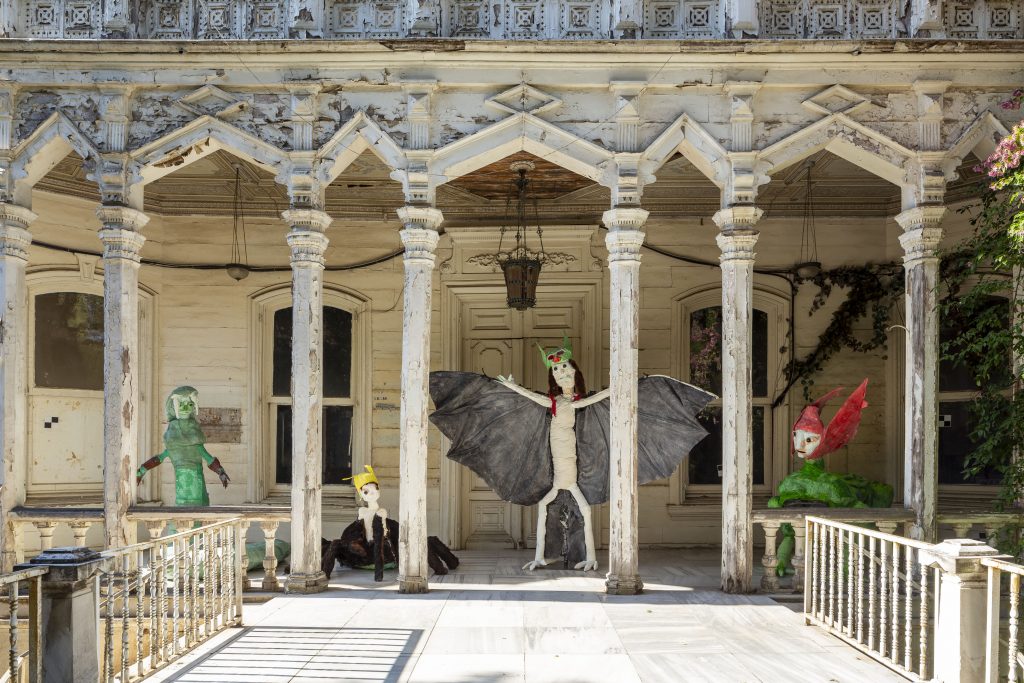
Monster Chetwynd, Hybrid Creatures, 2019. Courtesy the artist and Sadie Coles HQ London. Photograph: David Levene.
It is on the veranda of a crumbling wooden palazzo that the artist, Monster Chetwynd has installed her sculptures of hybrid creatures. The works, which she recounts celebrate the ‘grotesque, humorous and spooky’, see a snake, a crocodile, a spider, and a bat, take elements of a humanoid form. Using household objects, including washing-up gloves and bin bags the monsters appear on the house’s porch as if they are children dressed in anticipation to perform a self-written play. But there is also a more sinister side to the work – the location of the pieces in front of the decaying mansion, once a place of wealth and prosperity, a structure created for humans, by humans and left to rot by humans, finds a new life as the backdrop and host to contemporary art, as the new home for a motley crew of creatures – animals whose habitats could have once been found on the island, but due to construction have been uprooted and displaced. The human adaptation of the animals confronts the notion of our impact, yes in a playful way, but also in one that leaves visitors feeling somewhat out of sorts and reflective.
Further into the wooded island lies a site-specific work by Turkish artist, Hale Tenger. ‘Appearence’, a mixed-media and sound installation, occupies the garden of Sophronius Palace, once the summer house of the Ecumenical Patriarch Sophronius III. A collection of circular mirrors are placed amongst the wild stretch of grass, loomed over by the imposing building. Visitors are able to walk between the stands and view the Palace from various distorted angles. In tandem, a poem, read by the artist in both English and Turkish is audible. The words discuss agency, power and self-knowledge, with the intention to create a space for reflection and introspection. In this instance, as opposed to manifesting a new culture or conjuring an imagined world, Tenger instead has altered a historically loaded site with the intention to bring newness of a different kind, one of self-regeneration.
Back on the mainland, at the largest site of the Biennial, the Istanbul Painting and Sculpture Museum, 38 contemporary artists are each given their own dedicated space. It is at this venue that we arguably see the most interaction and comment on the climate crisis, with works by the Feral Atlas Collective and Suzanne Treister, which incorporate active research, commenting on the state of the world and how human impact is effecting our environment. Pieces at the Biennial by Feral Atlas Collective, a group of over a 100 scientists, humanists and artists, present issues including underwater noise pollution in the arctic and a mud volcano that has emerged next to a drilling rig in Indonesia.
In addition to the human impact on the world and its negative effects on nature, a collection of artists at the Biennial have also chosen to depict how human developments across technology and our changing landscapes have come to alter and potentially destroy human interactions, physicality and compassion.
A stunning film by the artist Rashid Johnson, titled ‘The Hikers’, sees two men wearing masks move through nature, initially on their own separate journeys. Taking the form of modern ballet, each dancer navigates the landscape in a sense of free, but somber isolation. Eventually the two meet, and on doing so tenderly interact. It is here that they remove their masks, finding a moment of connection in each other’s presence, before replacing their facades and continuing individually. The curator commented that the film is a ‘testament to the anxiety of navigating unfamiliar spaces and the comfort that can be found in the presence of another who shares aspects of your identity’.

Johannes Butler, The possibility of another life expresses itself directly in a cop car on fire and obliquely in the faces of my friends, 2019. Courtesy the artist. Photograph: David Levene.
An additional artist whose work addresses themes of physicality and sense of self is Johannes Butler. For the Biennial, Butler has created 7 sculptures, which take distorted human forms. Created from different types of earth and each with the skeleton of a machine, the forms resemble maimed bodies and futuristic soldiers, all broken and turned on their heads. The isolated figures continue the artist’s fascination and fear of a world in which people operate alone, hunched over screens, swiping, tapping and scrolling, ensnared in para-social interactions with armies of artificial agents.
On speaking to the Director of the Biennial, Bige Orer, she explained that it was important to balance the local context with the international art world, ensuring that the Biennial, which is for a specific city, at a specific moment in time, was engaging to both residents of Istanbul and those visiting from afar. A main aim of the Biennial was to also inspire younger generations. In addition to her work on Büyükada, Monster Chetwynd has created a permanent artwork, which takes the form of a children’s playground, in the shape of a giant Gorgon’s head, situated in the in the city’s Maçka Sanat Park. The Biennial’s aim to encourage children to interact with art and ultimately discover that it is exciting and fun is crucial in instilling agency and motivation in these future generations.
It is on encountering works across the city, in open plan galleries, hidden rooms and decaying mansions, that viewers are constantly forced to reconsider the themes of the Biennial, as each artist presents their own ideas and questions. Its effect and ultimate success will be in how audiences take forward their experiences, and the significance that these encounters will have in their day-to-day lives. In essence, this year’s Istanbul Biennial seems to set a precedent, identifying that the art world and artists have, and must react, to the responsibility that their public access allows; to continue to shout, paint and dance about the climate crisis, in order to instil awareness and change.
The 16th Istanbul Biennial, The Seventh Continent, runs until the 10 November 2019 at various locations across Istanbul, Turkey.

